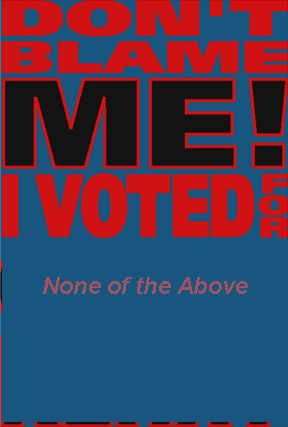Welcome to Shadow-Wars Prophecy & Conspiracy Site.We Travel around the United States in our Antique Winnebago monitoring the airwaves and the internet, to bring you what we believe to be the truth. The powers behind the scene, better known as the Shadow Government. |
|
After the storm, US media held to account for exaggerated tales of Katrina chaos By Andrew Gumbel in Los Angeles Published: 28 September 2005 Found here ! http://news.independent.co.uk/world/americas/article315511.ece After the storm, US media held to account for
exaggerated tales of Katrina chaos
One month after the storm, however, it appears that few, if any, of the most lurid reports breathlessly repeated on American television, echoed in official statements and duly reported in many of the world's newspapers, had any basis in fact. Several reporters and officials who have revisited the emblematic sites of the peculiarly chaotic hell that was New Orleans in the wake of Katrina now say the death toll at the Superdome was just six - and four of those were the result of natural causes. The fifth victim overdosed on drugs and the sixth committed suicide. If there were shootings or stabbings, none were fatal. At the convention centre, where The New York Times recently reported a death toll of 24 amid scenes of gun violence and rank fear, health and law enforcement officials have now told the New Orleans Times-Picayune newspaper that they recovered four bodies, of which only one showed signs of having been murdered. Police have confirmed just four homicides in the city in the week after the hurricane - about average for one of America's most crime-ridden metropolitan areas. While it now seems certain the initial lurid stories were exaggerated - some, including the purported rape of a seven-year-old, were repeated by the city's mayor and police chief, only to be disavowed much later - it may still be too soon to paint an exact picture of what happened in the chaotic days following the collapse of New Orleans's levee system, when 80 per cent of the city was submerged and the federal government became ever more glaringly evident by its absence. Some of the distortions were due to the collapse of communications and the sense of horror at what was unfolding. Some were the hallmark of an over-eager, under-informed news media - who, six years ago, managed to get wronng almost all the basic details of the shootings at Columbine High School in Colorado. And some of it appears to have been fuelled by fear of - occasionally bordering on bigotry towards - a poor, desperate, largely black population. In New Orleans' whiter, affluent western suburbs, stories spread after the hurricane of gangs of looters taking over one community after another. No such thing happened. Residents openly described the urban poor as " animals" and indicated they were willing to believe just about anything about them. Once the National Guard arrived in the city, soldiers charged with securing the perimeter of the Superdome warned journalists they would not be safe going inside. The inside turned out to be chaotic, fetid and stiflingly hot, but very far from the violent hellhole advertised. "It just morphed into this mythical place where the most unthinkable deeds were being done," Ed Bush of the National Guard told yesterday's Los Angeles Times. Only now, one month later, is the record being set straight. Even as far afield as Baton Rouge, the state capital 80 miles to the north-west, rumours of a crime wave created by thousands of evacuees from New Orleans triggered such a panic that the campus of Louisiana State University was locked down for almost a day. Police later said the only crime they had logged in the city was a single minor incident involving a knife at a temporary shelter. Nobody was hurt . Fact and fiction * MYTH: Shootings and stabbings at the Superdome. TRUTH: If there were, they were not fatal. * MYTH: 24 dead at convention centre amid gun violence. TRUTH: Four bodies recovered, one showed signs of murder. * MYTH: Affluent suburbs taken over by gangs of looters. TRUTH: Looters did not take over communities. * MYTH: In Baton Rouge, evacuees created a crime wave. (In the atmosphere of panic Louisiana State University was locked down.) TRUTH: One crime occurred in the city; a minor incident involving a knife at a temporary shelter. No one was hurt. The stories out of New Orleans in the immediate aftermath of Hurricane Katrina were little short of sickening: armed gangs terrorising evacuees in the Superdome and convention centre, bodies piling up by the dozen amid the stench and human waste, bodies stuffed into a freezer, children raped, murdered and thrown into waste bins. One month after the storm, however, it appears that few, if any, of the most lurid reports breathlessly repeated on American television, echoed in official statements and duly reported in many of the world's newspapers, had any basis in fact. Several reporters and officials who have revisited the emblematic sites of the peculiarly chaotic hell that was New Orleans in the wake of Katrina now say the death toll at the Superdome was just six - and four of those were the result of natural causes. The fifth victim overdosed on drugs and the sixth committed suicide. If there were shootings or stabbings, none were fatal. At the convention centre, where The New York Times recently reported a death toll of 24 amid scenes of gun violence and rank fear, health and law enforcement officials have now told the New Orleans Times-Picayune newspaper that they recovered four bodies, of which only one showed signs of having been murdered. Police have confirmed just four homicides in the city in the week after the hurricane - about average for one of America's most crime-ridden metropolitan areas. While it now seems certain the initial lurid stories were exaggerated - some, including the purported rape of a seven-year-old, were repeated by the city's mayor and police chief, only to be disavowed much later - it may still be too soon to paint an exact picture of what happened in the chaotic days following the collapse of New Orleans's levee system, when 80 per cent of the city was submerged and the federal government became ever more glaringly evident by its absence. Some of the distortions were due to the collapse
of communications and the sense of horror at what was unfolding. Some were
the hallmark of an over-eager, under-informed news media - who, six years
ago, managed to get wronng almost all the basic details of the shootings
at Columbine High School in Colorado. And some of it appears to have been
fuelled by fear of - occasionally bordering on bigotry towards - a poor,
desperate, largely black population.
The inside turned out to be chaotic, fetid and stiflingly hot, but very far from the violent hellhole advertised. "It just morphed into this mythical place where the most unthinkable deeds were being done," Ed Bush of the National Guard told yesterday's Los Angeles Times. Only now, one month later, is the record being set straight. Even as far afield as Baton Rouge, the state capital 80 miles to the north-west, rumours of a crime wave created by thousands of evacuees from New Orleans triggered such a panic that the campus of Louisiana State University was locked down for almost a day. Police later said the only crime they had logged in the city was a single minor incident involving a knife at a temporary shelter. Nobody was hurt . Fact and fiction * MYTH: Shootings and stabbings at the Superdome. TRUTH: If there were, they were not fatal. * MYTH: 24 dead at convention centre amid gun violence. TRUTH: Four bodies recovered, one showed signs of murder. * MYTH: Affluent suburbs taken over by gangs of looters. TRUTH: Looters did not take over communities. * MYTH: In Baton Rouge, evacuees created a crime wave. (In the atmosphere of panic Louisiana State University was locked down.) TRUTH: One crime occurred in the city; a minor incident involving a knife at a temporary shelter. No one was hurt.  |
| This site contains copyrighted material the use of which has not always been specifically authorized by the copyright owner. We are making such material available in our efforts to advance understanding of environmental, political, human rights, economic, democracy, scientific, and social justice issues, etc. We believe this constitutes a 'fair use' of any such copyrighted material as provided for in section 107 of the US Copyright Law. In accordance with Title 17 U.S.C. Section 107, the material on this site is distributed without profit to those who have expressed a prior interest in receiving the included information for research and educational purposes. For more information, go to: http://www.law.cornell.edu/uscode/17/107.shtml. If you wish to use copyrighted material from this site for purpose of your own that go beyond 'fair use', you must obtain permission from the copyright owner. |

